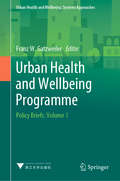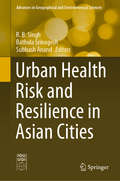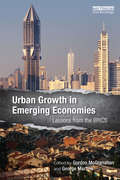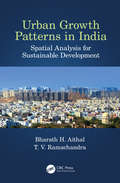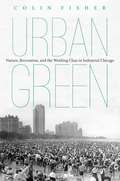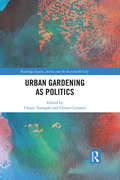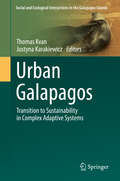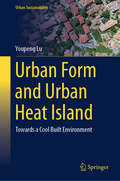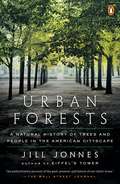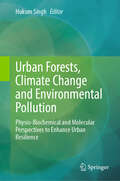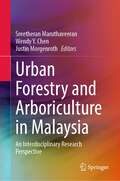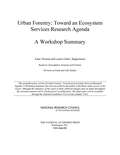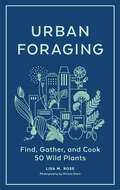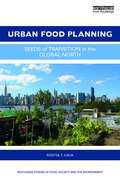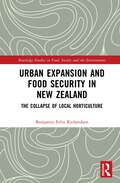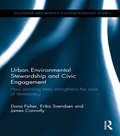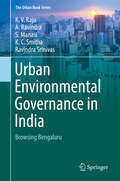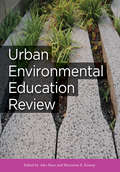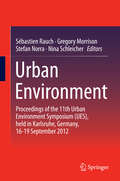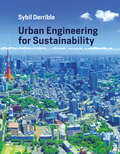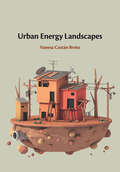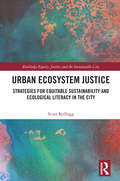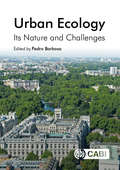- Table View
- List View
Urban Health and Wellbeing Programme: Policy Briefs: Volume 1 (Urban Health and Wellbeing)
by Franz W. GatzweilerThis book is a compilation of the policy briefs produced by the International Science Council’s program on Urban Health and Wellbeing: A Systems Approach over the past five years. Intended for urban decision-makers at all levels, it highlights policy-relevant findings and research insights to encourage the co-creation of knowledge for healthy urban environments and people. The book shows how variations on the systems approach developed and promoted by the program have been implemented in regions around the world and contributed to improving urban health. These policy briefs summarize research findings and scientific events concerning urban health-related topics that are relevant for public health professionals, urban planners, urban stakeholder groups and the public at large.
Urban Health Risk and Resilience in Asian Cities (Advances in Geographical and Environmental Sciences)
by R. B. Singh Bathula Srinagesh Subhash AnandThis book focuses on understanding urban vulnerability and risk mitigation, advancing good health and wellbeing, and analysing resilience measures for various Asian cities. Today, cities are the dominant human habitat, where a large number of environmental, social, cultural and economic factors have impacts on human health and wellbeing. Cities consist of complex, dynamic, socio-ecological, and technological systems that serve multiple functions in human health and wellbeing. Currently half of Asia’s population is urban, and that figure is expected to rise to 66 percent by 2050. Since urban areas are often most vulnerable to hazards, the people living in them need good health infrastructure facilities and technological support at various scales. As such, the need of the hour is to enhance the adaptive capacity, strengthen resilience, reduce vulnerability, and take risk mitigation measures in urban areas, which requires a systematic approach based on science–policy interface that is transformative, trans-disciplinary and integrative for a sustainable urban future. Global sustainable development goals are closely tied to urban human health and wellbeing: (1) the third of the United Nations’ Sustainable Development Goals is to “Ensure healthy lives and promote wellbeing for all at all ages” and (2) the eleventh is to “Make cities inclusive, safe, resilient and sustainable”. By addressing these goals, this book offers a highly useful resource for anyone concerned with healthy and resilient cities in Asia, today and tomorrow.
Urban Growth in Emerging Economies: Lessons from the BRICS
by George Martine Gordon McGranahanAlong with globalization, urban transitions have been central in the southward shift in economic power towards the newly emerging economies. As this book shows, however, these transitions have not been painless, and it is important for the rest of the urbanizing world to learn from the mistakes. It examines the role of urbanization and urban growth in the emerging economies, taking the BRICS countries (Brazil, Russia, India, China and South Africa) as case studies. Their different approaches towards urbanization have shaped their historical development paths and assisted or constrained their futures. Several of the BRICS bear heavy burdens from past failures to accommodate urban growth inclusively and efficiently, and many other urbanizing countries in Asia and Africa are in danger of replicating their mistakes. The overriding lesson of the book is that cities and nations must anticipate urbanization, and accommodate urban growth pro-actively, so as not to be left with an enduring legacy of inequalities and lost opportunities. This book is aimed at students and researchers in urban studies and development studies. It will also be of interest to policy advisors concerned with urbanization and the role of cities in a country’s development
Urban Growth Patterns in India: Spatial Analysis for Sustainable Development
by Bharath H. Aithal T. V. RamachandraThis book uses spatio-temporal analysis to understand urbanisation in Indian cities and explain the concept and impact of global greenhouse gas (GHG) emissions. It creates a GHG footprint for Indian cities and engages in a discussion about the United Nations Sustainable Development Goals (SDGs) and smart city initiatives within an Indian context. Understanding the spatial patterns of land use/land cover (LULC) dynamics in the rapidly urbanising cities of India, the readers will be able to simulate future urbanisation patterns and use spatial temporal analysis as a tool for implementing appropriate mitigation measures. Features Analyses the complete urbanisation and urban sprawl of major cities in India using advanced geospatial modelling techniques Highlights the best practices and methods used in modelling urban growth Discusses greenhouse gas emissions from various sectors and their effects in local environments Addresses the increase of local temperature in cities due to unplanned land use change and its impact on environmental sustainability and resilience Fills the need for data-driven governance and policy decisions by introducing various analyses through spatial mapping Highlighting some of the best practices and tools being used for modelling urban growth through case studies, the book is useful to those interested in using new technologies and methods for data collection and problem solving. It focuses on the major environmental issues in India, which are prevalent in most developing countries.
Urban Green
by Colin FisherIn early twentieth-century America, affluent city-dwellers made a habit of venturing out of doors and vacationing in resorts and national parks. Yet the rich and the privileged were not the only ones who sought respite in nature. In this pathbreaking book, historian Colin Fisher demonstrates that working-class white immigrants and African Americans in rapidly industrializing Chicago also fled the urban environment during their scarce leisure time. If they had the means, they traveled to wilderness parks just past the city limits as well as to rural resorts in Wisconsin and Michigan. But lacking time and money, they most often sought out nature within the city itself--at urban parks and commercial groves, along the Lake Michigan shore, even in vacant lots. Chicagoans enjoyed a variety of outdoor recreational activities in these green spaces, and they used them to forge ethnic and working-class community. While narrating a crucial era in the history of Chicago's urban development, Fisher makes important interventions in debates about working-class leisure, the history of urban parks, environmental justice, the African American experience, immigration history, and the cultural history of nature.
Urban Gardening as Politics (Routledge Equity, Justice and the Sustainable City series)
by Chiara Certomà Chiara TornaghiWhile most of the existing literature on community gardens and urban agriculture share a tendency towards either an advocacy view or a rather dismissive approach on the grounds of the co-optation of food growing, self-help and voluntarism to the neoliberal agenda, this collection investigates and reflects on the complex and sometimes contradictory nature of these initiatives. It questions to what extent they address social inequality and injustice and interrogates them as forms of political agency that contest, transform and re-signify ‘the urban’. Claims for land access, the right to food, the social benefits of city greening/community conviviality, and insurgent forms of planning, are multiplying within policy, advocacy and academic literature; and are becoming increasingly manifested through the practice of urban gardening. These claims are symptomatic of the way issues of social reproduction intersect with the environment, as well as the fact that urban planning and the production of space remains a crucial point of an ever-evolving debate on equity and justice in the city. Amid a mushrooming over positive literature, this book explores the initiatives of urban gardening critically rather than apologetically. The contributors acknowledge that these initiatives are happening within neoliberal environments, which promote –among other things - urban competition, the dismantling of the welfare state, the erasure of public space and ongoing austerity. These initiatives, thus, can either be manifestation of new forms of solidarity, political agency and citizenship or new tools for enclosure, inequality and exclusion. In designing this book, the progressive stance of these initiatives has therefore been taken as a research question, rather than as an assumption. The result is a collection of chapters that explore potentials and limitations of political gardening as a practice to envision and implement a more sustainable and just city.
Urban Galapagos: Transition to Sustainability in Complex Adaptive Systems (Social and Ecological Interactions in the Galapagos Islands)
by Thomas Kvan Justyna KarakiewiczThis book addresses the future of urbanisation on the Galapagos Islands from a systems, governance and design perspective with the competing parameters of liveability, economic and ecological, using the Galapagos as a laboratory for the theoretical and postulative understanding of evolving settlement and habitation. The Galapagos islands are one of the world’s most examined and reported examples of a series of naturally evolving ecosystems. The biodiversity of these island ecosystems are the focus of tourism and the image across the world yet human settlement are part of the local ecology. While human intervention is limited, the islands are a distinctive context in which to consider the impact of human habitation as a part of our ecosystems. In this book, authors take the framework of complex adaptive systems (CAS) in which to model systems that grow and evolve, the relations between these various sectors change; systems that get more complex as they evolve. Tested and applied discretely in the two realms of natural and urban, for the first time this text will bring the two together in understanding options for the future of urban settlements on the Galapagos Islands and, by extension, consider how the approach can be used globally in other contexts.
Urban Form and Urban Heat Island: Towards a Cool Built Environment (Urban Sustainability)
by Youpeng LuThis book provides a comprehensive exploration of the spatial patterns, drivers, mechanisms and management strategies associated with urban heat islands (UHI). It presents new insights into how urban form shapes the thermal environment of cities, shedding light on previously unexplored aspects of UHI dynamics and urban cooling strategies. The key features of this book include: 1. Comprehensive coverage of the influence of urban form on UHI intensity, from spatial patterns to regulatory strategies. 2. Practical implications and recommendations for urban planning and policy formulation to mitigate UHI effects and enhance urban sustainability. Written for researchers, urban planners, policymakers and environmental practitioners, this book provides valuable insights into understanding and addressing the challenges posed by UHI in rapidly urbanising environments. It is suitable for advanced graduate level courses in urban studies, environmental science and geography.
Urban Forests: A Natural History of Trees and People in the American Cityscape
by Jill Jonnes"Far-ranging and deeply researched, Urban Forests reveals the beauty and significance of the trees around us." --Elizabeth Kolbert, Pulitzer Prize-winning author of The Sixth Extinction"A comprehensive look at the trees of American cities . . . this book deserves [great interest]; indeed, no one who has loved a single tree will be able to set it aside." --Kirkus ReviewsA celebration of urban trees and the Americans--presidents, plant explorers, visionaries, citizen activists, scientists, nurserymen, and tree nerds--whose arboreal passions have shaped and ornamented the nation's cities, from Jefferson's day to the present Nature's largest and longest-lived creations, trees play an extraordinarily important role in our cityscapes, living landmarks that define space, cool the air, soothe our psyches, and connect us to nature and our past. Today, four fifths of Americans live in or near cities, surrounded by millions of trees, urban forests containing hundreds of species. Despite the ubiquity and familiarity of those trees, most of us take them for granted and know little of their specific natural history or civic virtues. Jill Jonnes's Urban Forests is a passionate, wide-ranging, and fascinating natural history of the tree in American cities over the course of the past two centuries. Jonnes's survey ranges from early sponsors for the Urban Tree Movement to the fascinating stories of particular species (including Washington, DC's famed cherry trees, and the American chestnut and elm, and the diseases that almost destroyed them) to the institution of Arbor Day to the most recent generation of tree evangelists who are identifying the best species to populate our cities' leafy canopies. The book examines such questions as the character of American urban forests and the effect that tree-rich landscaping might have on commerce, crime, and human well-being. As we wrestle with how to repair the damage we have wrought on nature and how to slow climate change, urban forests offer an obvious, low-tech solution. (In 2006, U.S. Forest Service scientist Greg McPherson and his colleagues calculated that New York City's 592,000 street trees annually saved $28 million in energy costs through shading and cooling, or $47.63 per tree.)From the Hardcover edition.
Urban Forests, Climate Change and Environmental Pollution: Physio-Biochemical and Molecular Perspectives to Enhance Urban Resilience
by Hukum SinghThis book contributes significantly to the international literature by bringing forth a novel and comprehensive exploration of urban resilience in the face of climate change and environmental pollution. Its focus on integrating physiological, biochemical, and molecular dimensions distinguishes it from existing literature. The book offers several key contributions, including an interdisciplinary approach to understanding the complex interactions within urban ecosystems. It includes cutting-edge insights that have not been extensively explored in existing literature, practical applications, and evidence-based strategies to enhance urban sustainability and resilience. The book has a global relevance to a diverse international readership and provides strategic guidance to policymakers and urban planners when making decisions to develop evidence-based strategies that cater to the specific challenges of cities. Urban forests play a critical role in enhancing the resilience of cities by providing numerous benefits, including improved air quality, reduced urban heat island effect, and enhanced biodiversity, ultimately improving urban health. Besides, urban forests are a crucial natural-based solution (NbS) to mitigate air pollution and climate change impacts in cities. However, in the face of climate change and environmental pressures, urban forests face significant challenges to their survival and functionality. This book explores the complex morpho-physio-biochemical and molecular changes that enable urban forests to flourish amidst climate change and environmental pollution. It examines how urban trees modulate their morphological structures, including root systems and physiological and biochemical functioning, and molecular alterations to withstand changing urban climatic and environmental conditions.
Urban Forestry and Arboriculture in Malaysia: An Interdisciplinary Research Perspective
by Sreetheran Maruthaveeran Wendy Y. Chen Justin MorgenrothThis book represents the latest research on urban forestry in a Malaysian context. It demonstrates that urban forestry is concerned not only with environmental enhancement, but also other aspects, such as recreation, health and well-being, and government policies. This edited collection provides a comprehensive overview of urban forestry studies from various researchers in Malaysia, and includes rich historical perspectives of urban forestry in the country. It also tackles related issues in policy. The greening of urban Malaysia in the 1970s focused primarily on beautification and was primarily the province of horticulturists, landscapers, nursery workers, town planners, and architects, with negligible inputs from foresters, particularly urban foresters. Perhaps for that reason, the term “landscaping” has been used more widely than “urban forestry” by government and private institutions, politicians, stakeholders, academicians, and the public. Nevertheless, the authors show that the concept of urban forestry is not new for developing countries such as Malaysia, where urbanization is increasing at a rapid rate. The book unpacks this demographic shift from a predominantly rural to a principally urban society. As the only unified body of work on urban forestry and arboricultural studies in Malaysia, this volume presents an important interdisciplinary reference for students, researchers, and scholars in physical geography, forestry and urban forestry, arboriculture and landscape architecture, both in Malaysia, and in other developing urbanizing countries, particularly in Southeast Asia. It is also an important resource for those working in environmental policy and practice, excavating the vital connection between the environment and well-being.
Urban Forestry
by National Research Council Division on Earth and Life Studies Board on Atmospheric Sciences and Climate Laurie Geller Katie ThomasMuch of the ecological research in the past decades has focused on rural or wilderness areas. Today, however, ecological research has been taking place in our cities, where our everyday decisions can have profound effects on our environment. This research, or urban ecology, includes an important element, trees. Trees have had a variety of environmental benefits for our environment including the sequestering carbon, reducing urban heat island effects, providing vital habitat for wildlife, and making nature accessible. These benefits have important impacts on the physical, socio-economic, and mental health of humans as well. Being exposed to trees has been shown to enhance social cohesion, improve health and recreational opportunities, and increase real estate values. In order to gain more knowledge into this urban forestry, the National Academy of Sciences (NAS) held a workshop February 25-26, 2013. The workshop brought together more than 100 people with various interests in urban forestry research to share information and perspectives, foster communication across specific areas of ecosystem service research, and consider integrated approaches that cut across these realms. The workshop specifically examined current capabilities to characterize and quantify the benefits, key gaps in our understanding, the challenges of planning urban forests in a way that optimizes multiple ecosystem services and more. Urban Forestry: Toward an Ecosystem Services Research Agenda: A Workshop Summary presents an overview of the issues discussed by the workshop's breakout groups; summarizes presentations from the four panels which included Biophysical Services of the Urban Forest; and context for the study with introductory material from the workshop.
Urban Foraging: Find, Gather, and Cook 50 Wild Plants
by Lisa M. RoseYour city is full of wild food, you just need to know where to find it. Take a stroll to discover the ingredients for a wild apple tarte tatin. Turn the lilac bush found in a vacant lot into a delicious, delicately flavored jelly for your morning pastry. Discover a new way to feast on fresh food. Urban Foraging is a stylish, scrumptious guide to wildcrafting in the city. You&’ll learn how to find, identify, harvest, and cook with 50 common wild plants, such as chickweed, dandelion, echinacea, honeysuckle, red clover, and pine. Expert forager Lisa M. Rose shares all the basics necessary for a successful harvest: clear photos that aid identification, tips for ethical and safe gathering, details on culinary uses, and simple recipes will help you make truly fresh, nutritious meals.
Urban Food Planning: Seeds of Transition in the Global North (Routledge Studies in Food, Society and the Environment)
by Rositsa T. IlievaThis highly original work examines the rise of the urban food planning movement in the Global North and provides insights into the new relationship between cities and food which has started developing over the past decade. It sheds light on cities as new spaces for food system innovation and on food as a tool for sustainable urban development. Drawing insights from the literature on socio-technical transitions, the book presents examples of pioneering urban food planning endeavours from North America and Western Europe (especially the Netherlands and the UK). These are integrated into a single mosaic helping to uncover the conceptual, analytical, design, and organizational innovations emerging at the interface of food and urban policy and planning. The author shows how promising "seeds of transition" to a shared urban food planning agenda are in the making, though the urban food planning niche as a whole still lacks the necessary maturity to lastingly influence mainstream planning practices and the dominant agri-food system regime. Some of the strategic levers to cope with the current instability and limitations of urban food planning and effectively transition it from a marginal novelty to a normalized domain of policy, research, and practice are systematically examined to this end. The conclusions and recommendations put forward have major implications for scholars, activists, and public officials seeking to radically transform the co-evolution of food, cities, and the environment.
Urban Expansion and Food Security in New Zealand: The Collapse of Local Horticulture (Routledge Studies in Food, Society and the Environment)
by Benjamin Felix RichardsonThis book examines suburban development in New Zealand and its conflict with and impact on local horticulture and food security. Drawing on an ethnographic study of Auckland’s rapidly expanding urban periphery, combined with comparative case studies from California in the USA and Victoria in Australia, the book examines how the profit-making strategies of property developers and landowners drastically reshapes work and life at the edge of cities. With a significant portion of the world's croplands lying adjacent to cities, the accelerating pace of urban sprawl across the planet places unprecedented pressure on the productivity and even existence of these vital food bowl regions. The book examines how the demand for more land for development at the urban periphery collides with concerns over local food security and the protection of ecosystem services. It analyses land use policy, historical records, and physical patterns of development, alongside participant observation of local events. It combines this with interviews with government officials, property developers, landowners, local residents and horticulturists. By combining these narratives of the hectic and lucrative business of suburban property development with the collapse of local horticulture, this book shows how the realignment of the New Zealand's interests of financial profitability over other concerns led to the transformation of urban peripheries from a productive food bowl to an investment vehicle. This book will be of great interest to students and scholars of urban food and agriculture, urban planning and development and rural-urban studies.
Urban Environmental Stewardship and Civic Engagement: How planting trees strengthens the roots of democracy (Routledge Explorations in Environmental Studies)
by Dana R. Fisher Erika S. Svendsen James ConnollyOnce considered the antithesis of a verdant and vibrant ecosystem, cities are now being hailed as highly efficient and complex social ecological systems. Emerging from the streets of the post-industrial city are well-tended community gardens, rooftop farms and other viable habitats capable of supporting native flora and fauna. At the forefront of this transformation are the citizens living in the cities themselves. As people around the world increasingly relocate to urban areas, this book discusses how they engage in urban stewardship and what civic participation in the environment means for democracy. Drawing on data collected through a two-year study of volunteer stewards who planted trees as part of the MillionTreesNYC initiative in the United States, this book examines how projects like this can make a difference to the social fabric of a city. It analyses quantitative survey data along with qualitative interview data that enables the volunteers to share their personal stories and motivations for participating, revealing the strong link between environmental stewardship and civic engagement. As city governments in developed countries are investing more and more in green infrastructure campaigns to change the urban landscape, this book sheds light on the social importance of these initiatives and shows how individuals’ efforts to reshape their cities serve to strengthen democracy. It draws out lessons that are highly applicable to global cities and policies on sustainability and civic engagement.
Urban Environmental Governance in India: Browsing Bengaluru (The Urban Book Series)
by K. V. Raju S. Manasi A. Ravindra K. C. Smitha Ravindra SrinivasThis book aims to identify the challenges presented by current urban environmental governance practices in fast growing Indian cities, to propose changes to the current governance implementation strategies, and to explore the best practices to achieve sustainable urban models through Indian and global perspectives. With a focus on the city of Bengaluru, the book draws on extensive reviews of literature and data to present current trends and statuses of environmental resource use in growing urban centres of India.The book analyzes the situations that impact urban environmental governance decisions and outcomes and proposes solutions to address these issues for long-term sustainability. Policy makers, researchers, academics and development practitioners in environmental politics and urban governance will find this work of great interest.The book starts by examining different urban environmental threats on global and domestic levels, and provides evidence for the effectiveness of sustainable efforts to curb the impact of crisis-like scenarios. Then the book discusses the role of institutional regimes in influencing urban environmental outcomes through policies, and analyzes the role of various actors in the evolution of urban environmental governance from a legal perspective at global and local scales. In the final chapters, the book explores the trends and status of environmental resource management in Bangalore Metropolitan Area (BMA), and examines the dynamics of local institutions and governance structures for regulating environmental governance for promoting effective sustainable environmental governance in Bengaluru.
Urban Environmental Education Review (Cornell Series in Environmental Education)
Urban Environmental Education Review explores how environmental education can contribute to urban sustainability. Urban environmental education includes any practices that create learning opportunities to foster individual and community well-being and environmental quality in cities. It fosters novel educational approaches and helps debunk common assumptions that cities are ecologically barren and that city people don't care for, or need, urban nature or a healthy environment.Topics in Urban Environmental Education Review range from the urban context to theoretical underpinnings, educational settings, participants, and educational approaches in urban environmental education. Chapters integrate research and practice to help aspiring and practicing environmental educators, urban planners, and other environmental leaders achieve their goals in terms of education, youth and community development, and environmental quality in cities.The ten-essay series Urban EE Essays, excerpted from Urban Environmental Education Review, may be found here: naaee.org/eepro/resources/urban-ee-essays. These essays explore various perspectives on urban environmental education and may be reprinted/reproduced only with permission from Cornell University Press.
Urban Environment
by Sébastien Rauch Gregory Morrison Stefan Norra Nina SchleicherOver half of the global population now lives in cities. This ongoing urbanisation is making it increasingly important to adequately manage urban systems and preserve urban environments. This book is the outcome of the 11th Urban Environment Symposium (UES) held on 16-19 September 2012 in Karlsruhe, Germany. The UES aims at providing a forum on the sciences and practices needed to promote a sustainable future in urban environments. Papers by leading experts are presented in sections on Urban Management and Spatial Planning, Green Cities and Urban Ecosystems, Urban Planning and Development, Air Quality and Noise, Urban Climate Change and Adaptation, and Contamination of Urban Waters and its Effects.
Urban Engineering for Sustainability (The\mit Press Ser.)
by Sybil DerribleA textbook that introduces integrated, sustainable design of urban infrastructures, drawing on civil engineering, environmental engineering, urban planning, electrical engineering, mechanical engineering, and computer science.This textbook introduces urban infrastructure from an engineering perspective, with an emphasis on sustainability. Bringing together both fundamental principles and practical knowledge from civil engineering, environmental engineering, urban planning, electrical engineering, mechanical engineering, and computer science, the book transcends disciplinary boundaries by viewing urban infrastructures as integrated networks. The text devotes a chapter to each of five engineering systems—electricity, water, transportation, buildings, and solid waste—covering such topics as fundamentals, demand, management, technology, and analytical models. Other chapters present a formal definition of sustainability; discuss population forecasting techniques; offer a history of urban planning, from the Neolithic era to Kevin Lynch and Jane Jacobs; define and discuss urban metabolism and infrastructure integration, reviewing system interdependencies; and describe approaches to urban design that draw on complexity theory, algorithmic models, and machine learning. Throughout, a hypothetical city state, Civitas, is used to explain and illustrate the concepts covered. Each chapter includes working examples and problem sets. An appendix offers tables, diagrams, and conversion factors. The book can be used in advanced undergraduate and graduate courses in civil engineering and as a reference for practitioners. It can also be helpful in preparation for the Fundamentals of Engineering (FE) and Principles and Practice of Engineering (PE) exams.
Urban Energy Landscapes
by Vanesa Castán BrotoThe urban energy transition represents a transformation of such magnitude that it will require a re-examination of the fundamental relationship between societies and energy resources. The potential for cities to deliver sustainable energy for their citizens requires context-specific action. One-size-fits-all approaches - which assume homogeneity across cities and economies of scale in the extension of electricity networks - have largely failed to deliver sustainable energy for all. This challenge is existential, questioning the fundamental ways in which contemporary life is organized around energy. This innovative volume argues that the urban energy transition depends on specific urban trajectories and heterogeneous urban energy landscapes, reflecting both strategic projects of urbanization and people's dwelling practices. Looking at in-depth case studies of urban energy landscapes in four major cities, it calls for citizens' active engagement with experimentation in everyday life. The book will have wide interdisciplinary appeal to researchers in energy, urban and environmental studies.
Urban Ecosystems
by Frederick R. Adler Colby J. TannerAs humans have come to dominate the earth, the ideal of studying and teaching ecology in pristine ecosystems has become impossible to achieve. Our planet is now a mosaic of ecosystems ranging from the relatively undisturbed to the completely built, with the majority of people living in urban environments. This accessible introduction to the principles of urban ecology provides students with the tools they need to understand these increasingly important urban ecosystems. It builds upon the themes of habitat modification and resource use to demonstrate how multiple ecological processes interact in cities and how human activity initiates chains of unpredictable unintended ecological consequences. Broad principles are supported throughout by detailed examples from around the world and a comprehensive list of readings from the primary literature. Questions, exercises and laboratories at the end of each chapter encourage discussion, hands-on study, active learning, and engagement with the world outside the classroom window.
Urban Ecosystem Justice: Strategies for Equitable Sustainability and Ecological Literacy in the City (Routledge Equity, Justice and the Sustainable City series)
by Scott KelloggMerging together the fields of urban ecology, environmental justice, and urban environmental education, Urban Ecosystem Justice promotes building fair, accessible, and mutually beneficial relationships between citizens and the soils, water, atmospheres, and biodiversity in their cities. This book provides a framework for re-centering issues of justice and fairness in sustainability discourse while challenging the profound ecological alienation experienced by urban residents. While the urban sustainability movement has had many successes in the past few decades, there remain areas for it to grow. For one, the benefits of sustainability have disproportionately benefited wealthier city residents, with concerns over equity, justice, and social sustainability frequently taking a back seat to economic and environmental considerations. Additionally, many city dwellers remain estranged from and unfamiliar with ecological processes, with urban environments often thought of as existing outside of nature or as hopelessly degraded. Through a citizen-centered lens, the book offers a guide to reconciling these issues by demonstrating how questions of equity, access, and justice apply to the biophysical dimensions of the urban ecosystem: soil, water, air, waste, and biodiversity. Drawing heavily from the fields of urban ecology, environmental justice, and ecological design, this book lays out a science of cities for people: a pedagogical platform that can be used to promote ecological literacy in underrepresented urban communities through affordable and decentralized means. This book provides both a theoretical and practical field guide to students and researchers of urban sustainability, city planners, architects, policymakers, and activists wishing to develop reciprocal relationships with urban ecologies.
Urban Ecology: Its Nature and Challenges
by Steven Frank Pedro Barbosa Aaron M Grade Adam J Terando Amanda E Sorensen Dennis VanEngelsdorp Elsa Youngsteadt Desiree L Narango Gail A Langellotto Heidi Liere Holly Martinson Ignacio Castellanos Iriana Zuria John G Kelcey Katherine Straley Lea Johnson Lindsay Miller Barranco Lisa Kuder Michael J Raupp Monika Egerer Nancy B Grimm Nancy Falxa Sonti Paige S Warren Rebecca C Jordan Riley Andrade Steward T Pickett Susannah B LermanToday, 55% of the world's human population lives in urban areas. By 2030, up to 90% of the global human population will live in cities and the global population is expected to increase by 68% by 2050. Although land cover categorized as "urban" is a relatively small fraction of the total surface of the Earth, urban areas are major driving forces in global environmental change, habitat loss, threats to biodiversity, and the loss of terrestrial carbon stored in vegetation biomass. These and many other factors highlight the need to understand the broad-scale impacts of urban expansion as it effects the ecological interactions between humans, wildlife and plant communities. In a series of essays by leading experts this book defines urban ecology, and provides much-needed focus on the main issues of this increasingly important subdiscipline such as the impacts of invasive species, protecting pollinators in urban environments, the green cities movement and ecological corridors. The book stresses the importance of understanding ecological forces and ecosystem services in urban areas and the integration of ecological concepts in urban planning and design. The creation of urban green spaces is critical to the future of urban areas, enhancing human social organization, human health and quality of life. Urban ecology is becoming a foundational component of many degree programs in universities worldwide and this book will be of great interest to students and researchers in ecology and conservation science, and those involved in urban planning and urban environmental management.
Urban Ecology: An Introduction
by Ian Douglas Philip JamesUrban Ecology: An Introduction seeks to open the reader’s mind and eyes to the way in which nature permeates everyday urban living, and how it has to be understood, cared for, and managed in order to make our towns and cities healthier places to visit and in which to live and work. The authors examine how nature can improve our physical and mental health, the air we breathe and the waters we use, as well as boosting our enjoyment of parks and gardens. Urban Ecology sets out the science that underlies the changing natural scene and the tools used to ensure that cities become both capable of adapting to climate change and more beautiful and resilient. The book begins with a discussion of the nature of urban places and the role of nature in towns and cities. Part 1 looks at the context and content of urban ecology, its relationship to other foci of interest within ecology and other environmental sciences, and the character of city landscapes and ecosystems. In Part 2 the authors set out the physical and chemical components of urban ecosystems and ecological processes, including urban weather and climate, urban geomorphology and soils, urban hydrology and urban biogeochemical cycles. In Part 3 urban habitats, urban flora and fauna, and the effects of, deliberate and inadvertent human action on urban biota are examined. Part 4 contains an exploration of the identification and assessment of ecosystem services in urban areas, emphasising economic evaluation, the importance of urban nature for human health and well-being, and restoration ecology and creative conservation. Finally, in Part 5 the tasks for urban ecologists in optimising and sustaining urban ecosystems, providing for nature in cities, adapting to climate change and in developing the urban future in a more sustainable manner are set out. Within the 16 chapters of the book – in which examples from around the world are drawn upon - the authors explore current practice and future alternatives, set out procedures for ecological assessment and evaluation, suggest student activities and discussion topics, provide recommended reading and an extensive bibliography. The book contains more than 150 tables and over 150 photographs and diagrams.
